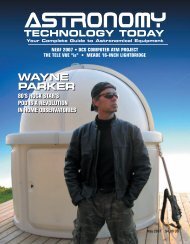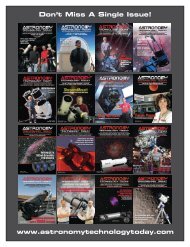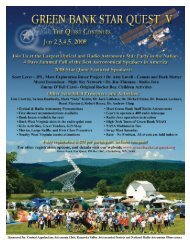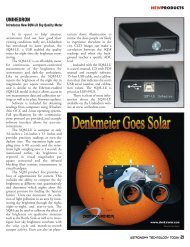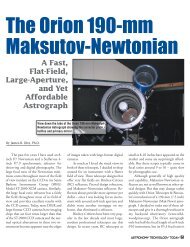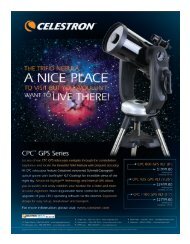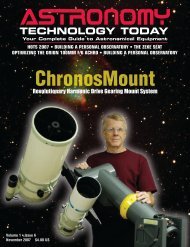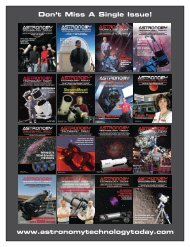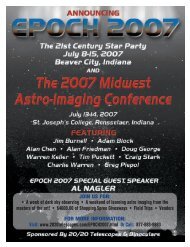iOPTRON - Astronomy Technology Today
iOPTRON - Astronomy Technology Today
iOPTRON - Astronomy Technology Today
You also want an ePaper? Increase the reach of your titles
YUMPU automatically turns print PDFs into web optimized ePapers that Google loves.
A HOT TOPIC - ACTIVE COOLING OF A PRIMARY TELESCOPE MIRROR<br />
Figure 6: 60 minutes of cooling with beginning temperature of 36-inch<br />
mirror of 20°C but beginning and ending temperature of the air at 5°C; air<br />
recirculated with fans; mirror temperatures measured at thicknesses of<br />
30 mm, 45 mm and 65 mm; temperature Delta of 0°C, 1.0°C, and 2.0°C,<br />
color-coded to 30 minutes.<br />
Figure 5: 240 minutes of cooling with a beginning temperature of ambient-air<br />
and 36-inch mirror of 20°C and ending ambient of 5°C; primary<br />
cooled with fans; mirror temperatures measured at thicknesses of 30<br />
mm, 45 mm and 65 mm; temperature Delta of 1.5°C, 2.0°C and 3.0°C.<br />
duced yet still-massive 36-inch<br />
mirror: No fan or system of<br />
fans would get the mirror to<br />
less than one-degree Celsius of<br />
night-time air by using nighttime<br />
air as the cooling media if<br />
the mirror temperature started<br />
out as warm as day-time air.<br />
So, another project was born.<br />
Using the calculator<br />
again, I found that, if I had access<br />
to air pre-cooled to 5°C, I<br />
could cool the 36-inch mirror<br />
much faster. I might meet my<br />
goal of one-hour cooling by recirculating<br />
the pre-cooled air<br />
through the mirror box, but as<br />
an added bonus, by using precooled<br />
air, the mirror cooling<br />
process could be started when<br />
the Sun was still up – when<br />
any other scope would still be<br />
waiting for the as-yetunavailable<br />
cooler air of twilight<br />
– as demonstrated in<br />
Figures 6-8, which show the<br />
mirror cooled with fan-recirculated<br />
pre-cooled 5°C air at<br />
intervals of 30, 45 and 60<br />
minutes respectively.<br />
For each of the three typical<br />
glass thicknesses that comprise<br />
my mirror, the outer ring<br />
(the portion not honeycombed)<br />
would take the<br />
longest to cool, as expected,<br />
but it would certainly be possible<br />
to cool the entire mass of<br />
the mirror, including the core<br />
of thicker parts, in about an<br />
hour if I could find the source<br />
of 5°C air. So, in Microsoft<br />
Excel, my favorite CAD software,<br />
I laid out an overview<br />
drawing (Figure 9) to better<br />
understand where parts reside<br />
within the telescope, where<br />
hose attachments could be<br />
made, what circulation issues I<br />
might encounter, etc.<br />
I dug through boxes in<br />
my garage and found meters<br />
to monitor temperature but,<br />
more importantly, to also<br />
measure humidity or dew<br />
point. What I wouldn’t want<br />
to find when I pulled the mirror<br />
cover off for observing was<br />
Figure 7: 60 minutes of cooling with beginning temperature of 36-inch<br />
mirror of 20°C but beginning and ending temperature of the air at 5°C; air<br />
recirculated with fans; mirror temperatures measured at thicknesses of<br />
30 mm, 45 mm and 65 mm; temperature Delta of 0°C, 0.25°C, and<br />
1.0°C, color-coded to 45 minutes.<br />
Figure 8: 60 minutes of cooling with beginning temperature of 36-inch<br />
mirror of 20°C but beginning and ending temperature of the air at 5°C; air<br />
recirculated with fans; mirror temperatures measured at thicknesses of<br />
30 mm, 45 mm and 65 mm; temperature Delta at all glass thicknesses<br />
are under 0.25°C.<br />
<strong>Astronomy</strong> TECHNOLOGY TODAY 55



